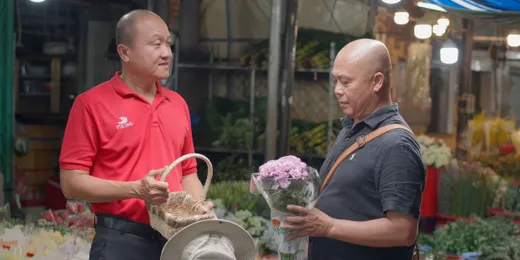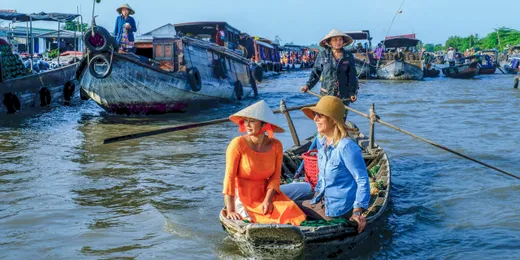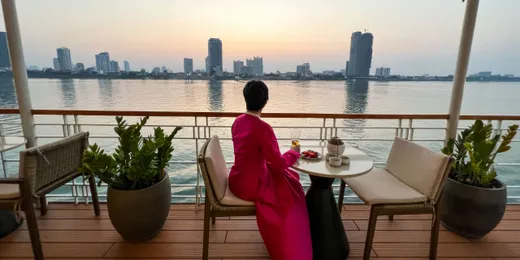
Embark on a memorable voyage through Vietnam
Vietnam is home to lush landscapes, rich history and vibrant cultural treasures. Read on to learn more about the geography of this enchanting country and enhance your knowledge of the Mekong Delta. Uncover the origins of pho, an iconic Vietnamese soup, and delve into the story behind Vietnam’s ubiquitous three-wheeled bicycle taxis, known as cyclos.

Vietnam
Vietnam is located on the eastern Indochinese Peninsula. It borders China to the north, Laos and Cambodia to the west and the South China Sea to the east. With a surface area of 127,880 sq mi. (331,207 sq km), the country is slightly larger than the US state of New Mexico.
Mostly hilly and densely forested, Vietnam is home to a rich and diverse array of vegetation. Ebony, teak, palms, mangroves and bamboo are among the more than 1,500 species of woody plants found in the country. Northern Vietnam is situated at the edge of a tropical climate zone, and the annual average temperature in Hanoi is 74°F (23°C). Farther south, in Ho Chi Minh City, the annual average temperature is 81°F (27°C). January is the country’s coolest month, with an average monthly temperature of 63°F (17°C) in Hanoi.
While Hanoi is the capital of Vietnam, Ho Chi Minh City (formerly Saigon) is the most populous city. HCMC, as some locals call it, lies along the Saigon River to the north of the Mekong Delta, about 50 mi. (80 km) from the South China Sea. Ho Chi Minh City was the capital of the French protectorate of Cochinchina from 1862 to 1954, and the city contains many prominent examples of French colonial architecture, such as the grand Saigon Central Post Office and the Saigon Notre-Dame Basilica. Vestiges of France’s cultural influence can also be found in regional cuisine. For example, one of Vietnam’s signature dishes, bánh mì, consists of a French-style baguette filled with traditional Vietnamese ingredients such as chả lụa sausage, cilantro and pickled daikon.
Vietnam is one of the world's richest agricultural regions, and rice production—much of which takes place in the Mekong Delta—is a cornerstone of Vietnam’s economy. Many banana, coconut and citrus plantations can also be found in the fertile delta. Given the country’s long coastline and excellent harbors, it comes as little surprise that the export of shrimp, squid, crab and lobster has also become a major source of foreign trade.
With its picturesque villages and thriving cities, Vietnam offers visitors a wide range of attractions. Some of the county’s most notable landmarks include:
- Bến Thành Market—This sprawling complex in Ho Chi Minh City is home to a historic, bustling market. Visitors can discover a profusion of tempting food displays and savory dishes, including Vietnamese pancakes (bánh xèo), spring rolls (gỏi cuốn), steamed rice cakes (bánh bèo) and noodle soup (pho), and explore the market's array of handicrafts, lacquerware and embroidery.
- Hanoi’s Old Quarter—Boasting more than 600 pagodas and temples, Hanoi’s Old Quarter is comprised of narrow streets and architecture from the early 20th century. The street names reveal the quarter’s long tradition of trade, with each one dedicated to a traditional Vietnamese product. From Hàng Bạc (silver) to Hàng Bồ (baskets) and Hàng Bông (cotton) to Hàng Đào (silk), almost any item can be found at a store or market stall.
- Hạ Long Bay—Designated a UNESCO World Heritage Site in 1994, Hạ Long Bay’s more than 1,600 islands form a stunning collection of towering limestone pillars. According to local lore, dragons created this majestic place after the gods sent them to protect locals from marauders. The protective beasts breathed countless jewels into the bay, sinking the approaching ships and creating a breathtaking seascape.
- Sa Ðéc—This old French colonial river port was one of the largest cities in the Mekong Delta prior to the 19th century. Today, it is a charming town featuring tree-lined streets and old villas surrounded by orchards. Sa Ðéc gained prominence as the childhood home of Marguerite Duras, one of France’s best-known authors.

-
Cuisine—Vietnamese pho
Undoubtedly one of Vietnam’s most famous dishes, pho’s seemingly humble simplicity belies its wonderfully complex flavor profile. Consisting of little more than rice noodles, herbs and meat in beef broth, these modest ingredients combine to form a uniquely flavorful soup that is beloved worldwide.
Pho originated around the turn of the 20th century in Vietnam’s northern region and is thought to have been influenced by both French and Chinese cooking. Rice noodles, a Chinese specialty, were a common soup ingredient, as were slices of traditional Vietnamese water buffalo meat. At the time, cows were used as draft animals rather than a source of food. When the French occupation began and there was suddenly an abundance of leftover beef bones due to the colonizers’ desire for steak, enterprising vendors recognized an opportunity to create a new, distinctly Vietnamese dish.
Inspired by the cooking technique used to make beef broth for pot au feu, a French beef stew, this new soup, featuring beef instead of water buffalo, soon became a northern favorite. During the turbulent mid-20th century, pho made its way south to Saigon (now Ho Chi Minh City), where it acquired a stronger taste due to the introduction of regional ingredients like bean sprouts, Thai basil and fermented bean paste. This divide can still be seen today, with pho in Hanoi (pho bac) exhibiting a simpler, more rustic character than Ho Chi Minh City’s ingredient-heavy, spicy-sweet offerings (pho nam).
Should you find yourself exploring the streets of one of Vietnam’s major metropolitan areas in the morning hours, you are likely to spot vendors selling pho by the bowlful, surrounded by hungry patrons sitting outside on small stools or upturned milk crates. Many Vietnamese, particularly those who work as laborers, believe pho to be the ideal breakfast—substantial enough to provide sustenance throughout the morning, yet light enough not to feel too heavy in the stomach.
Given its status as the nation’s breakfast of choice, some stalls sell out of the day’s supply well before noon. Today, more Vietnamese citizens work in offices today than ever before. For many of these workers, the traditional breakfast pho has shifted to lunchtime, a change which is reflected in vendors adopting extended serving hours.
Although pho’s flavor and grounded appeal have made it a popular menu item across the globe, do not pass up the opportunity to enjoy this Vietnamese classic in the land of its creation.
-
Culture—The Mekong Delta
The Mekong Delta—a maze of canals, rivers and streams—counts Khmer pagodas, coconut plantations and villages surrounded by rice paddies among its many treasures. It is a triangular plain of approximately 15,000 sq mi. (38,849 sq km) that begins in Cambodia, where the Mekong River meets the Tonle Sap channel and the Bassac River. There, the Mekong divides into six main channels and the Bassac into three to form the “nine dragons” that stretch down into Vietnam’s outer delta and beyond to the South China Sea. The region also includes Vietnam’s largest island, Phú Quốc, known for its agriculture, white-sand beaches and fast-growing tourism sector.
Beginning in the latter half of the 19th century, French colonists ruled over Vietnam, and during this period, the Vietnamese peasants living in and around the Mekong Delta tilled and tamed this fertile area. The land here is so low-lying that the tides have been known to reach as far as 186 mi. (300 km) inland. Since ancient times, the area has acted like a sponge, storing water during the monsoon season and releasing it once the rains have ceased. In doing so, the land is not only irrigated but refreshed with rich soil. This makes it so naturally productive that Vietnam has become one of the world’s leading exporters of rice. Incredibly, despite making up just 10 percent of Vietnam’s total land mass, the Mekong Delta is where more than one-third of the country’s yearly food crop is produced.
The Mekong Delta is also one of Vietnam’s most densely populated regions—its inhabitants, predominantly ethnic Viet, also include a large population of Khmers. Several notable movies have been filmed in the Mekong Delta, including The Floating Lives (2010), Buffalo Boy (2004) and Francis Ford Coppola’s epic war film Apocalypse Now (1979). Badly damaged during the war, the forests of the delta were where the Viet Cong concealed their bases. Fifty years later, they have been replanted, and rare animals long thought to be extinct have recovered. Today, the peaceful sounds that define this tropical jungle include the calls of birds, rustling palm fronds and small boats crossing the currents.
-
History—Vietnam’s cyclos
The rickshaw, invented in Japan in 1869, initiated an explosion of personal mobility methods in Asia in the late 19th and early 20th centuries. Around the same time, modern, chain-driven, pedal-powered bicycles were rolling off assembly lines, and enterprising rickshaw-pullers were chopping up bicycles and attaching them to their rickshaws. These three-wheeled bicycle taxis appeared in Vietnam during the French colonial period and were dubbed cyclos.
Initially, the authorities in Saigon (now Ho Chi Minh City) found the cyclo to be too revolutionary in its design. In response, Pierre Coupeaud, a Frenchman who owned a bicycle company in Phnom Penh, decided to stage a timed cyclo journey between the Cambodian capital and Saigon. On February 9, 1936, two cyclists completed the 149-mile (240 km) trek in just 17 hours and 20 minutes, a feat which achieved its intended goal of bringing cyclos to Saigon en masse. Within six years, cyclos had replaced rickshaws as the city’s preferred method of transportation.
Cyclos are generally pedal-driven by a driver sitting behind the rider, who occupies a double seat supported by two front wheels. Today, they are used primarily for carrying bulky loads and as an entertaining form of transportation. With no fossil fuel emissions, they are environmentally beneficial and may be faster than other forms of transportation if congestion is heavy; however, their presence is banned from major thoroughfares for being a traffic hazard.
Cyclos are ideal for catching a glimpse of street scenes that you cannot see any other way, such as in Hanoi’s Old Quarter. Not only can traveling by cyclo show you more than you could cover on foot without becoming exhausted, they are also a pleasant way to relax after a long, hot day of sightseeing on foot.
If you want to hire a cyclo, it is a good idea to negotiate the fare in advance. Generally speaking, it is wise to offer about a third of the driver’s quoted price and then bargain your way up to no more than half. And before you take off, remember to have your camera at the ready to snap photos of the unlikely loads that cyclos are known to carry, consisting of everything from bedroom furniture to live pigs.
Vietnam Highlights
A journey through Vietnam promises exceptional scenic beauty, historic charm and lively cities that artfully blend the old and new. Here are some highlights you may experience on your voyage through this vibrant country:
- Sample a steaming bowl of pho in Ho Chi Minh City
- Descend into the Củ Chi tunnels used during the Vietnam War
- Cruise on a junk sailboat through stunning Hạ Long Bay
- Visit the impressive Imperial City and Citadel of Huế
- Explore Hanoi’s charming Old Quarter
- Ride in a traditional sampan boat along the Mekong River
- See the floating markets of Cái Bè
- View French colonial architecture in Sa Ðéc
- Discover the town of Hội An, a UNESCO World Heritage Site
- Learn about Buddhist and Zen practices at Yen Tu Monastery
- Attend a hands-on workshop at Bat Trang Pottery Village
- Watch a traditional water puppet show in Yen Duc
Destination Insight Videos
-
At Home in Ho Chi Minh City (13:38)
Join Viking Saigon Program Director, Ut Lam Thanh, for an introduction to the vibrant streets of Ho Chi Minh City, Vietnam’s largest metropolis. Immerse yourself in the sights and sounds of the iconic Bến Thàn Market and admire colorful blooms at Ho Thi Ky’s fresh flower market. Then, delve into the rich cultural heritage of Chinatown's Hao Sy Phuong Alley—a charming, centuries-old community of more than 200 households.
-
Uncover cuisine found along the Mekong River with Karine Hagen (6:54)
Journey along the Mekong River with Viking’s Karine Hagen and enhance your understanding of why this waterway truly is the “Mother River of Southeast Asia.” Karine is joined by one of her best friends, Chi, as they explore the floating markets along the Mekong Delta, observing boats brimming with tropical fruits, vegetables and other local delicacies. They later prepare a worldwide culinary favorite, Vietnamese summer rolls—known to locals as gỏi cuốn, which translates to “salad roll.” Learn how to prepare this light, delectable appetizer and a flavorful dipping sauce.
-
At Home on the Mekong Delta with Thu Tran (9:30)
Join local guide Thu Tran as she takes us on a tour of everyday life along the Mekong Delta in Vietnam. Thu has worked with Viking since 2015 and has been a tour guide for over 15 years. In this episode, follow Thu as she explores the food and vegetable markets of the Mekong Delta and the many farms that supply their produce.
-
Postcards from the Mekong River with photographer Alastair Miller (17:00)
Delve into the heart of Southeast Asia with British photographer Alastair Miller. Follow along as Alastair shares stunning photographs and captivating anecdotes from his recent travels during our 15-day Magnificent Mekong voyage. Enjoy seeing the traditional floating markets, serene landscapes and vibrant cultures that await your discovery on a Mekong River voyage with us.
Vietnam Travel FAQ
All-Inclusive Itineraries—Vietnam
Choose one of our enriching, all-inclusive voyages and discover the many benefits of exploring in Viking comfort.












